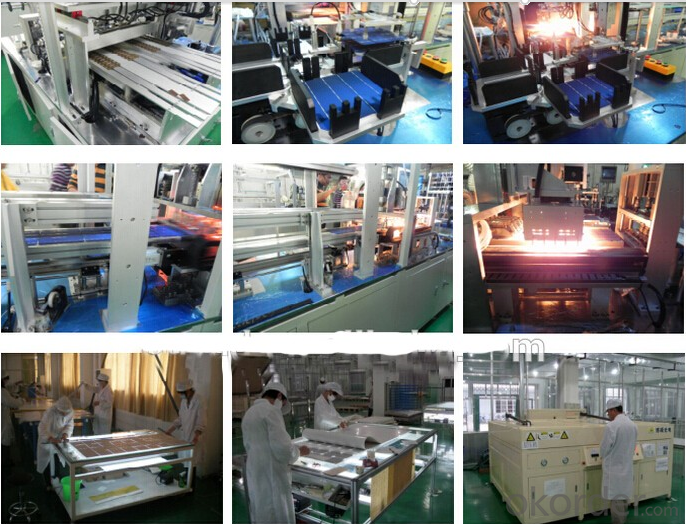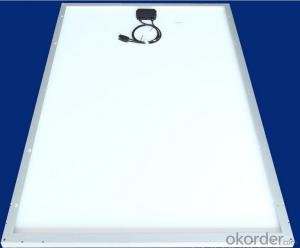CNBM Solar Monocrystalline 156mm Series 250W
- Loading Port:
- Shanghai
- Payment Terms:
- TT OR LC
- Min Order Qty:
- 1000 watt
- Supply Capability:
- 20000000 watt/month
OKorder Service Pledge
OKorder Financial Service
You Might Also Like
Item specifice
Materials
Silicon
Guarantee
12 yrs free from defects in materials and workmanship
No less than 90% within 10yrs and no less than 80% within 25yrs
TUV(IEC61215&IEC61730), CE, UL
Application
Photovoltaic/ solar/ green energy/ energy saving
Descriptions
1.High efficiency crystalline silicon solar cell. Even if under the weak light, the solar module can produce maximum power output.
2.Tempered glass (toughened glass): Anti-reflecting coating and high transmission rate glass increase the power output and mechanical strength of solar module.
3. EVA and TPT: Using high quality EVA and TPT to prevent destroying and water.
4. AI frame: Without screw, rner connection. 6 holes on the frame can be installed easily.
5. Junction box: Multi function junction box with water proof.
6. Long lifetime: ≥25 years; Less power decrease.
7. Good performance of preventing from atrocious weather such as wind and hails.
8. Resisting moisture and etching effectively, not effected by geology.
9. The certificate issued by international authority: UL, TUV, IEC, CE.
Packaging Details
26pcs/pallet, 28pallets/ 40HQ
Our solar panels are packed in cartons, and then pallet.
Shipping by sea or by air are both ok, it up to customer’s chose.
We’d like to inquiry the freight cost for customer after be informed exact quantity and destination address.
CNBM International Corporation is a professional solar panel manufacturer in China for CNBM brand . Silicon panel ( silicon module), as our main product, has high quality and good service. Our products are very popular in Europe, Australia, England, Middle East, Mexico, Argentina, Chili, Singapore and Africa.Furthermore, our products have gained international authorized certificates like TUV, UL and CE.



Why Choose Us
A. Professional Manufacturers , Strict quality control & power classification Silicon Solar PV Module
B. 100% A grade solar cell with Positive tolerance power range.
C. High Conversion Efficiency , High transmission rate , low iron tempered Anti-reflecting/coating film 3.2mm glass
D. Anti-aging & high visosity EVA
E. high frame resistant & Double-sided fluorine TPT
F. Anodized aluminum alloy high thickness frame
G. 3 or 6 bypass diodes , 90mm 4m2 cable , MC4 connectors & waterproof junction box
H. Long life, Easy installation, high wind & hail impact resistance
I. Be resistant to atmospheric exposure & effects of delamination
J. ISO9001:2008/ISO14001:2004/OHSAS18001:2007/ CE /TUV/CEC/ IEC/EN61215 IEC/EN61730/CHUBB INSURANCE
K. 10Years Manufacturing Quality Warranty , 10Years 90% Power output Warranty, 25Years 80% Power output Warranty
- Q:im aware i dont fully understand. but with what i do. if P = iv, and current changes with voltage, whats the point of changing either. if in any cicumstance, you end up with the same wattage, how does changing either effect a solar setup. (2v panel vs 24v)thanks in advance. explain in laymans if you can.
- The choice of solar panel voltage comes down more to what the panels will be connected to. You're right that power can remain the same at the different voltages. Higher input (panel) voltages are sometimes used in inverter systems to reduce the effect of voltage draw-down. 2v panels (about 20v open circuit) work well for charging 2v batteries, connected in parallel, through a charge controller. For use of a grid-tie inverter, higher input voltages are sometimes used to reduce the effects of draw-down. You want to select and wire (parallel vs. series) your panels based on the input voltage requirement of the load, whatever it may be.
- Q:Can solar panels be used in areas with frequent power outages?
- Yes, solar panels can be used in areas with frequent power outages. Solar panels generate electricity from sunlight, which means they can continue to produce power even during power outages. By installing battery storage systems, the excess energy generated during the daytime can be stored and used during periods of low sunlight or power outages. This allows solar panels to provide a reliable source of electricity in areas with frequent power outages.
- Q:How much electricity can a solar panel generate?
- The amount of electricity a solar panel can generate depends on factors such as its size, efficiency, location, and weather conditions. On average, a standard residential solar panel can generate around 250 to 400 watts per hour under optimal conditions. However, it is important to note that solar panels are typically installed in arrays, so the total electricity generation can be scaled up by adding more panels.
- Q:I have a solar panel, charge regulator, inverter....is that all I need to tie it into my grid? Do I just plug the solar panel into the charge regulator into the inverter into any 0v outlet? I feel like im missing something....
- No don't do that unless you want a fire or worse electricution . DO NOT PLUG INTO THE WALL . st solar panel 2nd regulator 3rd 2 volt battery 4th inverter . The inverter should have 0 volt terminals that look like the plug on the wall . You would plug your TV or light into that the inverter . You would need an electrition to hook into your home electrical system . They will hook up a device made to tie into the grid or your meter that will make it run backwards but it takes alot of solar panels too do that . Please do not plug into wall .
- Q:Can solar panels be used for powering electric fences?
- Yes, solar panels can be used to power electric fences. Solar panels can generate electricity that can be stored in batteries and used to power electric fence systems, providing a reliable and eco-friendly source of energy for the fences.
- Q:Can anyone give me a link to a website that sells really big solar panels? Enough to run a small cafe on entirely solar power.
- Just google search solar panels or pv panels and you should get a long list of them. That's what I did. Most of the sites selling them will also have the inverters etc that you'll need. Most likely you'll put several small or medium sized panels on your roof - as opposed to just one large one. You probably won't be able to run an entire cafe off of photovoltaic panels, even if you have a bank of batteries. Too many appliances running at the same time. Ask your electric utility company about net metering - you'll buy juice from them when your demand is high and sell to them when your demand is low - IF you can find a sunny day when you're not using juice, but if you have a restaraunt-sized refrigerator you probably won't be selling as much as you're buying. In effect, it won't eliminate your elec bill, just make it a bit smaller. Either way, you may be looking at spending $20,000 to cover the roof with PV panels and your savings won't pay that back any time soon. So, PV is not so great for a business. Much better for a home where you'll be at work all day the only appliances running in your house is your frig. Whatever you invest to solar your house will be repaid when you sell it, meanwhile you'll reduce your bills dramatically, especially if you convert all your indoor lighting to LEDs. On the other hand, the Googleplex, Google's office building full of computers, covered their roof with pv panels and claim to have reduced their monthly bill by /3. BUT, that's a huge building with lots of roof space.
- Q:I recently got into solar panels, I have little background in electronics but I have done a little electrical work in the past and just want to make a small 36 cell panel to power a 2v battery that would run my a small tv (9 inch) and PS3 for a few hours every night. I have been looking up on how to do it before I get in over my head and I have a few questions.... After you solder all of the cells together then what? Do you hook all of the rows of cells together somehow? Can you connect them straight to a battery? After you hook to the battery do you hook up a power inverter to get the 2 AC plugs that would be needed? Thanks in advance for any help....
- i'm involved approximately do-it yourselfers, i'm one, yet... Sorry to inform you, yet connecting image voltaic panels to grid capacity will require an electrician. there are a number of standards for specific disconnects to circumvent harm to the utillity corporation workers that would desire to be seen. you will additionally might desire to have an inverter sized to verify your panels. the straight forward answer is to connect your panels to something specific, without connecting it into your place wiring. An occasion is to connect your water properly pump to image voltaic capacity and disconnect it from the grid. yet you will nonetheless want an inverter and could might desire to calculate the capacity demands of the pump and the quantity of capacity available out of your panels, which varies via your longitude and variety. It sound like an straight forward element to do, yet without specific training and adventure you would be sorry in case you attempt this your self.
- Q:Can solar panels be installed on the ground instead of a roof?
- Yes, solar panels can be installed on the ground instead of a roof. Ground-mounted solar panels are a popular alternative when roofs are not suitable or available for installation. Ground-mounted systems offer flexibility in terms of placement, orientation, and size, making them an excellent option for maximizing solar energy production.
- Q:What is the principle and structure of solar panels?
- Solar power generation system consists of solar cells, solar controllers, batteries (group) composition. If the output power is AC 220V or 110V, also need to configure the inverter. The role of each part is
- Q:i don't know very much about it, but can you somehow take off the little solar panels off of the outdoor light things and make it so you can hook an outlet up to it and plug in to it like a phone charger for electricity.
- Little solar panels on lights are very low power. The battery in one such may be 0.5 Amp-hours and .2 V ; it may be different but it should be marked on the panel/battery/manual. An outlet in your house is designed to run on 20 V (typically in N. Am.) and they run on alternating current (AC) whereas the panel generates direct current (DC). (If you don't know the difference, do not worry to much but just understand that they are not directly compatible.) You therefore need an inverter to change DC to AC (and lose some although inverters are now very efficient). But the amount of power generated by those panels is still very small. That is why solar lights are low power (just a few watts in most cases). To make things even more irritating, phone chargers do not work off 20 V AC as you are charging the battery and need a low voltage DC -- which is what the solar panel is giving you. It is almost certain that the voltage from the panel will be less than the voltage required for the phone. The charger is mostly cable but there is a black box incorporated and it should say what the voltage and current output are (the input will be 20V). So you should be able to overcome this not by hooking up the panel to a 20V outlet and then plugging the charger in but by hooking up the panel to the phone directly if you can get enough voltage out of the solar panel (or hook up several) and if you fashion a connection device. They already make them -- solar battery chargers and I am sure you can enter that into a search engine and find loads. Typically the panel alone is much more than a solar light -- which shows the relative power requirements.
1. Manufacturer Overview |
|
|---|---|
| Location | |
| Year Established | |
| Annual Output Value | |
| Main Markets | |
| Company Certifications | |
2. Manufacturer Certificates |
|
|---|---|
| a) Certification Name | |
| Range | |
| Reference | |
| Validity Period | |
3. Manufacturer Capability |
|
|---|---|
| a)Trade Capacity | |
| Nearest Port | |
| Export Percentage | |
| No.of Employees in Trade Department | |
| Language Spoken: | |
| b)Factory Information | |
| Factory Size: | |
| No. of Production Lines | |
| Contract Manufacturing | |
| Product Price Range | |
Send your message to us
CNBM Solar Monocrystalline 156mm Series 250W
- Loading Port:
- Shanghai
- Payment Terms:
- TT OR LC
- Min Order Qty:
- 1000 watt
- Supply Capability:
- 20000000 watt/month
OKorder Service Pledge
OKorder Financial Service
Similar products
New products
Hot products
































